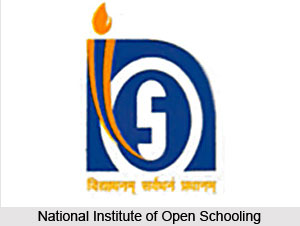 The National Institute of Open Schooling (NIOS) formerly known as National Open School (NOS) was established in November, 1989 as an autonomous organisation in pursuance of National Policy on Education 1986 by the Ministry of Human Resource Development (MHRD), Government of India. NIOS is providing a number of Vocational, Life Enrichment and community oriented courses besides General and Academic Courses at Secondary and Senior Secondary level. It also offers Elementary level Courses through its Open Basic Education Programmes (OBE). Government of India through a gazette notification vested NIOS with the authority to examine and certify learners registered with it upto pre degree level courses.
The National Institute of Open Schooling (NIOS) formerly known as National Open School (NOS) was established in November, 1989 as an autonomous organisation in pursuance of National Policy on Education 1986 by the Ministry of Human Resource Development (MHRD), Government of India. NIOS is providing a number of Vocational, Life Enrichment and community oriented courses besides General and Academic Courses at Secondary and Senior Secondary level. It also offers Elementary level Courses through its Open Basic Education Programmes (OBE). Government of India through a gazette notification vested NIOS with the authority to examine and certify learners registered with it upto pre degree level courses.
The main objectives of the NIOS are:
* To provide opportunities for continuing and developmental education at the school stage;
* To provide consultancy services to the Government of India and States;
* To serve as an agency for effective dissemination of information related to distance education and open learning;
* To identify and promote standards of learning in distance education system and state open schools; and
* To exercise normative and coordinating functions while promoting standards in distance and open learning system in the country.
Formation of NIOS
In 1986, the National Policy on Education suggested strengthening of Open School System for extending open learning facilities in a phased manner at secondary level all over the country as an independent system with its own curriculum and examination leading to certification. Consequently, the Ministry of Human Resource Development (MHRD), Government of India set up the National Open School (NOS) in November 1989. The pilot project of CBSE on Open School was amalgamated with NOS. Through a Resolution, the National Open School (NOS) was vested with the authority to register, examine and certify students registered with it up to pre-degree level courses. In July 2002, the Ministry of Human Resource Development amended the nomenclature of the organisation from the National Open School (NOS) to the National Institute of Open Schooling (NIOS) with a mission to provide relevant continuing education at school stage, up to pre-degree level through Open Learning system.
NIOS operates through a network of five Departments, eleven Regional Centres and 3367 Accredited Institutions (Study Centres) in India and abroad. It has a current enrolment of about 1.5 million students at Secondary and Senior Secondary levels which makes it the largest open schooling system in the world.
Activities of NIOS
The National Institute of Open Schooling (NIOS) provides opportunities to interested learners by making available the following Courses/Programmes of Study through open and distance learning (ODL) mode. It provides- Open Basic Education (OBE) Programme for 14+ years age group, adolescents and adults at A, B and C levels that are equivalent to classes III, V and VIII of the formal school system; Secondary Education Course; Senior Secondary Education Course; Vocational Education Courses/Programmes; Life Enrichment Programmes. The NIOS has established Regional Centres at the following places- Hyderabad , Pune, Kolkata, Guwahati, Chandigarh, Kochi, Delhi, Jaipur, Patna, Allahabad, Bhopal, Dehradun, Bhubaneshwar, Gandhinagar, Bengaluru and Imphal. Sub Centres have been set up at Darbhanga and Vishakapatnam.
The NIOS programmes pay special attention towards requirements of the first generation learners, physically, mentally and visually challenged learners and candidates from disadvantaged sections of the society.




















